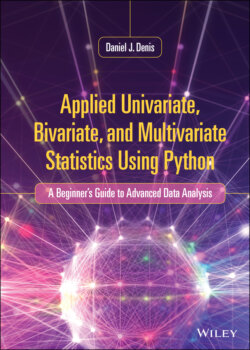Читать книгу Applied Univariate, Bivariate, and Multivariate Statistics Using Python - Daniel J. Denis - Страница 5
Contents
Оглавление1 Cover
2 Title page
3 Copyright
4 Dedication
5 Preface
6 Chapter 1: A Brief Introduction and Overview of Applied Statistics1.1 How Statistical Inference Works1.2 Statistics and Decision-Making1.3 Quantifying Error Rates in Decision-Making: Type I and Type II Errors1.4 Estimation of Parameters1.5 Essential Philosophical Principles for Applied Statistics1.6 Continuous vs. Discrete Variables1.6.1 Continuity Is Not Always Clear-Cut1.7 Using Abstract Systems to Describe Physical Phenomena: Understanding Numerical vs. Physical Differences1.8 Data Analysis, Data Science, Machine Learning, Big Data1.9 “Training” and “Testing” Models: What “Statistical Learning” Means in the Age of Machine Learning and Data Science1.10 Where We Are Going From Here: How to Use This BookReview Exercises
7 Chapter 2: Introduction to Python and the Field of Computational Statistics2.1 The Importance of Specializing in Statistics and Research, Not Python: Advice for Prioritizing Your Hierarchy2.2 How to Obtain Python2.3 Python Packages2.4 Installing a New Package in Python2.5 Computing z-Scores in Python2.6 Building a Dataframe in Python: And Computing Some Statistical Functions2.7 Importing a .txt or .csv File2.8 Loading Data into Python2.9 Creating Random Data in Python2.10 Exploring Mathematics in Python2.11 Linear and Matrix Algebra in Python: Mechanics of Statistical Analyses2.11.1 Operations on Matrices2.11.2 Eigenvalues and EigenvectorsReview Exercises
8 Chapter 3: Visualization in Python: Introduction to Graphs and Plots3.1 Aim for Simplicity and Clarity in Tables and Graphs: Complexity is for Fools!3.2 State Population Change Data3.3 What Do the Numbers Tell Us? Clues to Substantive Theory3.4 The Scatterplot3.5 Correlograms3.6 Histograms and Bar Graphs3.7 Plotting Side-by-Side Histograms3.8 Bubble Plots3.9 Pie Plots3.10 Heatmaps3.11 Line Charts3.12 Closing ThoughtsReview Exercises
9 Chapter 4: Simple Statistical Techniques for Univariate and Bivariate Analyses4.1 Pearson Product-Moment Correlation4.2 A Pearson Correlation Does Not (Necessarily) Imply Zero Relationship4.3 Spearman’s Rho4.4 More General Comments on Correlation: Don’t Let a Correlation Impress You Too Much!4.5 Computing Correlation in Python4.6 T-Tests for Comparing Means4.7 Paired-Samples t-Test in Python4.8 Binomial Test4.9 The Chi-Squared Distribution and Goodness-of-Fit Test4.10 Contingency TablesReview Exercises
10 Chapter 5: Power, Effect Size, P-Values, and Estimating Required Sample Size Using Python5.1 What Determines the Size of a P-Value?5.2 How P-Values Are a Function of Sample Size5.3 What is Effect Size?5.4 Understanding Population Variability in the Context of Experimental Design5.5 Where Does Power Fit into All of This?5.6 Can You Have Too Much Power? Can a Sample Be Too Large?5.7 Demonstrating Power Principles in Python: Estimating Power or Sample Size5.8 Demonstrating the Influence of Effect Size5.9 The Influence of Significance Levels on Statistical Power5.10 What About Power and Hypothesis Testing in the Age of “Big Data”?5.11 Concluding Comments on Power, Effect Size, and Significance TestingReview Exercises
11 Chapter 6: Analysis of Variance6.1 T-Tests for Means as a “Special Case” of ANOVA6.2 Why Not Do Several t-Tests?6.3 Understanding ANOVA Through an Example6.4 Evaluating Assumptions in ANOVA6.5 ANOVA in Python6.6 Effect Size for Teacher6.7 Post-Hoc Tests Following the ANOVA F-Test6.8 A Myriad of Post-Hoc Tests6.9 Factorial ANOVA6.10 Statistical Interactions6.11 Interactions in the Sample Are a Virtual Guarantee: Interactions in the Population Are Not6.12 Modeling the Interaction Term6.13 Plotting Residuals6.14 Randomized Block Designs and Repeated Measures6.15 Nonparametric Alternatives6.15.1 Revisiting What “Satisfying Assumptions” Means: A Brief Discussion and Suggestion of How to Approach the Decision Regarding Nonparametrics6.15.2 Your Experience in the Area Counts6.15.3 What If Assumptions Are Truly Violated?6.15.4 Mann-Whitney U Test6.15.5 Kruskal-Wallis Test as a Nonparametric Alternative to ANOVAReview Exercises
12 Chapter 7: Simple and Multiple Linear Regression7.1 Why Use Regression?7.2 The Least-Squares Principle7.3 Regression as a “New” Least-Squares Line7.4 The Population Least-Squares Regression Line7.5 How to Estimate Parameters in Regression7.6 How to Assess Goodness of Fit?7.7 R2 – Coefficient of Determination7.8 Adjusted R27.9 Regression in Python7.10 Multiple Linear Regression7.11 Defining the Multiple Regression Model7.12 Model Specification Error7.13 Multiple Regression in Python7.14 Model-Building Strategies: Forward, Backward, Stepwise7.15 Computer-Intensive “Algorithmic” Approaches7.16 Which Approach Should You Adopt?7.17 Concluding Remarks and Further Directions: Polynomial RegressionReview Exercises
13 Chapter 8: Logistic Regression and the Generalized Linear Model8.1 How Are Variables Best Measured? Are There Ideal Scales on Which a Construct Should Be Targeted?8.2 The Generalized Linear Model8.3 Logistic Regression for Binary Responses: A Special Subclass of the Generalized Linear Model8.4 Logistic Regression in Python8.5 Multiple Logistic Regression8.5.1 A Model with Only Lag18.6 Further DirectionsReview Exercises
14 Chapter 9: Multivariate Analysis of Variance (MANOVA) and Discriminant Analysis9.1 Why Technically Most Univariate Models are Actually Multivariate9.2 Should I Be Running a Multivariate Model?9.3 The Discriminant Function9.4 Multivariate Tests of Significance: Why They Are Different from the F-Ratio9.4.1 Wilks’ Lambda9.4.2 Pillai’s Trace9.4.3 Roy’s Largest Root9.4.4 Lawley-Hotelling’s Trace9.5 Which Multivariate Test to Use?9.6 Performing MANOVA in Python9.7 Effect Size for MANOVA9.8 Linear Discriminant Function Analysis9.9 How Many Discriminant Functions Does One Require?9.10 Discriminant Analysis in Python: Binary Response9.11 Another Example of Discriminant Analysis: Polytomous Classification9.12 Bird’s Eye View of MANOVA, ANOVA, Discriminant Analysis, and Regression: A Partial Conceptual Unification9.13 Models “Subsumed” Under the Canonical Correlation FrameworkReview Exercises
15 Chapter 10: Principal Components Analysis10.1 What Is Principal Components Analysis?10.2 Principal Components as Eigen Decomposition10.3 PCA on Correlation Matrix10.4 Why Icebergs Are Not Good Analogies for PCA10.5 PCA in Python10.6 Loadings in PCA: Making Substantive Sense Out of an Abstract Mathematical Entity10.7 Naming Components Using Loadings: A Few Issues10.8 Principal Components Analysis on USA Arrests Data10.9 Plotting the ComponentsReview Exercises
16 Chapter 11: Exploratory Factor Analysis11.1 The Common Factor Analysis Model11.2 Factor Analysis as a Reproduction of the Covariance Matrix11.3 Observed vs. Latent Variables: Philosophical Considerations11.4 So, Why is Factor Analysis Controversial? The Philosophical Pitfalls of Factor Analysis11.5 Exploratory Factor Analysis in Python11.6 Exploratory Factor Analysis on USA Arrests DataReview Exercises
17 Chapter 12: Cluster Analysis12.1 Cluster Analysis vs. ANOVA vs. Discriminant Analysis12.2 How Cluster Analysis Defines “Proximity”12.2.1 Euclidean Distance12.3 K-Means Clustering Algorithm12.4 To Standardize or Not?12.5 Cluster Analysis in Python12.6 Hierarchical Clustering12.7 Hierarchical Clustering in PythonReview Exercises
18 References
19 Index
20 End User License Agreement
